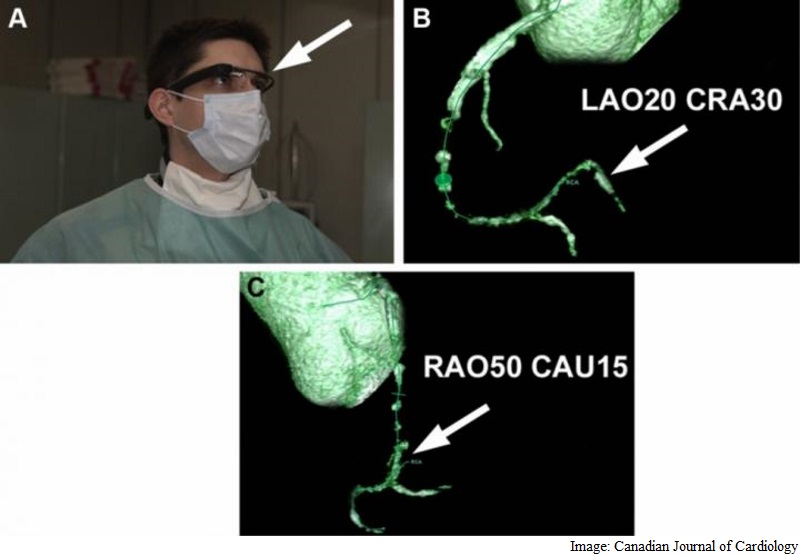- Home
- Wearables
- Wearables News
- Google Glass Helps Cardiologists Open Blocked Heart Artery
Google Glass Helps Cardiologists Open Blocked Heart Artery

Cardiologists from the Institute of Cardiology, Warsaw, Poland's capital city, successfully restored blood flow in the occluded right coronary artery of a 49-year-old male patient assisted by Google Glass with an optical head-mounted display.
The display of 3D computed tomographic reconstructions in a mobile application equipped with a hands-free voice recognition system and a zoom function enabled the physician-operators to clearly visualise the distal coronary vessel.
It helped them verify the direction of the guide wire advancement relative to the course of the blocked vessel segment.
The procedure was completed successfully with implantation of two drug-eluting stents.
"This case demonstrates the novel application of wearable devices for display of data sets in the catheterisation lab that can be used for better planning and guidance of interventional procedures," said lead investigator Maksymilian P Opolski from the Institute of Cardiology.
"It also provides proof of concept that wearable devices can improve operator comfort and procedure efficiency in interventional cardiology," Opolski added.
Google Glass, consists of a wearable, hands-free computer with an optical head-mounted display worn by interventional cardiologists in the catheterisation laboratory.
The optical head-mounted display can show and capture images and videos while interacting with the surrounding environment.
This display is an example of the concept of virtual reality in which the user is supplemented with additional information generated by the device.
"Mobile technology offers an incremental opportunity to expand the existing open platform for mobile applications, which overcome the economic and capacity limitations of advanced angiography systems with dedicated monitors for projection of Computed tomography angiography (CTA) data sets," Dr Opolski pointed out.
Furthermore, wearable devices might be potentially equipped with filter lenses that provide protection against X-radiation.
Several medical specialties are already using it to train physicians and assist diagnosis and it also has potential for treatment, said the report published in the Canadian Journal of Cardiology.
For the latest tech news and reviews, follow Gadgets 360 on X, Facebook, WhatsApp, Threads and Google News. For the latest videos on gadgets and tech, subscribe to our YouTube channel. If you want to know everything about top influencers, follow our in-house Who'sThat360 on Instagram and YouTube.
Related Stories
- Samsung Galaxy Unpacked 2025
- ChatGPT
- Redmi Note 14 Pro+
- iPhone 16
- Apple Vision Pro
- Oneplus 12
- OnePlus Nord CE 3 Lite 5G
- iPhone 13
- Xiaomi 14 Pro
- Oppo Find N3
- Tecno Spark Go (2023)
- Realme V30
- Best Phones Under 25000
- Samsung Galaxy S24 Series
- Cryptocurrency
- iQoo 12
- Samsung Galaxy S24 Ultra
- Giottus
- Samsung Galaxy Z Flip 5
- Apple 'Scary Fast'
- Housefull 5
- GoPro Hero 12 Black Review
- Invincible Season 2
- JioGlass
- HD Ready TV
- Laptop Under 50000
- Smartwatch Under 10000
- Latest Mobile Phones
- Compare Phones
- Moto G15 Power
- Moto G15
- Realme 14x 5G
- Poco M7 Pro 5G
- Poco C75 5G
- Vivo Y300 (China)
- HMD Arc
- Lava Blaze Duo 5G
- Asus Zenbook S 14
- MacBook Pro 16-inch (M4 Max, 2024)
- Honor Pad V9
- Tecno Megapad 11
- Redmi Watch 5
- Huawei Watch Ultimate Design
- Sony 65 Inches Ultra HD (4K) LED Smart TV (KD-65X74L)
- TCL 55 Inches Ultra HD (4K) LED Smart TV (55C61B)
- Sony PlayStation 5 Pro
- Sony PlayStation 5 Slim Digital Edition
- Blue Star 1.5 Ton 3 Star Inverter Split AC (IC318DNUHC)
- Blue Star 1.5 Ton 3 Star Inverter Split AC (IA318VKU)

















